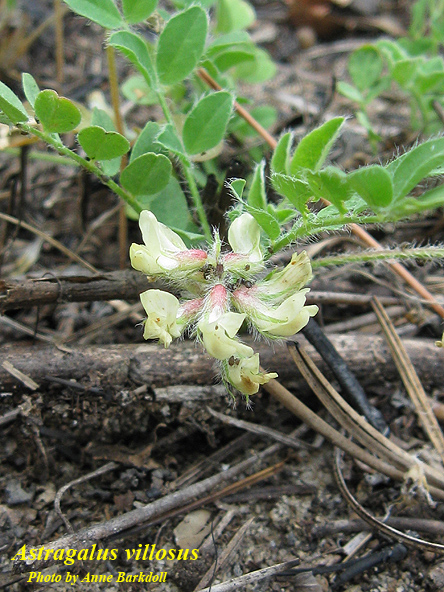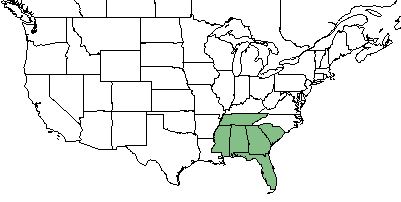Difference between revisions of "Astragalus villosus"
(→Ecology) |
|||
| Line 32: | Line 32: | ||
==Ecology== | ==Ecology== | ||
===Habitat=== <!--Natural communities, human disturbed habitats, topography, hydrology, soils, light, fire regime requirements for removal of competition, etc.--> | ===Habitat=== <!--Natural communities, human disturbed habitats, topography, hydrology, soils, light, fire regime requirements for removal of competition, etc.--> | ||
| − | ''A. villosus'' proliferates in sandhills and other loose, dry, sandy places. <ref name= "Weakley 2015"> Weakley, A. S. (2015). Flora of the Southern and Mid-Atlantic States. Chapel Hill, NC, University of North Carolina Herbarium. </ref> It can also be found in clay soils <ref name= "FSU | + | ''A. villosus'' proliferates in sandhills and other loose, dry, sandy places. <ref name= "Weakley 2015"> Weakley, A. S. (2015). Flora of the Southern and Mid-Atlantic States. Chapel Hill, NC, University of North Carolina Herbarium. </ref> It can also be found in clay soils, loose sand, loamy sand, pinewoods, old field, and burned pineland.<ref name = "FSU herbarium"> URL: http://herbarium.bio.fsu.edu. Last accessed: June 2018. Collectors: Loran C. Anderson, R.K. Godfrey, J.B. Nelson, Brenda Herring, Don Herring, R.Kral, M. Knott, LB Trott, Richard D. Houk, Delzie Demaree, D. Burch, George Cooley, Joseph Monachino, Rodie White, James W. Hardin, Wilbur H. Duncan, Ron Miller, Jim Lytton, Rod Wilson. States and counties: Florida (Leon, Wakulla, Franklin, Taylor, Santa Rosa, Escambia, Walton, Liberty, Madison, Lafayette, Lake, Columbie, Hernando, Gilchrist, Citrus, Clay) Georgia (Grady, Thomas) Alabama (Escambia)</ref> |
===Phenology=== <!--Timing off flowering, fruiting, seed dispersal, and environmental triggers. Cite PanFlora website if appropriate: http://www.gilnelson.com/PanFlora/ --> | ===Phenology=== <!--Timing off flowering, fruiting, seed dispersal, and environmental triggers. Cite PanFlora website if appropriate: http://www.gilnelson.com/PanFlora/ --> | ||
Revision as of 13:12, 20 June 2018
Common name: bearded milkvetch [1], southern milkvetch [2]
| Astragalus villosus | |
|---|---|

| |
| Photo by the Atlas of Florida Plants Database | |
| Scientific classification | |
| Kingdom: | Plantae |
| Division: | Magnoliophyta - Flowering plants |
| Class: | Magnoliopsida - Dicots |
| Order: | Fabales |
| Family: | Fabaceae |
| Genus: | Astragalus |
| Species: | A. villosus |
| Binomial name | |
| Astragalus villosus Michx. | |

| |
| Natural range of Astragalus villosus from USDA NRCS Plants Database. | |
Contents
Taxonomic Notes
Synonyms: Phaca intonsa (Sheldon) Rydberg ex Small
Varieties: none
Description
A. villosus is an annual forb/herb of the Fabaceae family native to North America. [1]
Distribution
A. villosus is found in the southeastern corner of the United States, specifically in Tennessee, Mississippi, Alabama, Georgia, South Carolina, and Florida. [1]
Ecology
Habitat
A. villosus proliferates in sandhills and other loose, dry, sandy places. [2] It can also be found in clay soils, loose sand, loamy sand, pinewoods, old field, and burned pineland.[3]
Phenology
A. villosus flowers February-April. [4]
Conservation and Management
Cultivation and restoration
Photo Gallery
References and notes
- ↑ 1.0 1.1 1.2 USDA Plant Database https://plants.usda.gov/core/profile?symbol=ASVI6
- ↑ 2.0 2.1 Weakley, A. S. (2015). Flora of the Southern and Mid-Atlantic States. Chapel Hill, NC, University of North Carolina Herbarium.
- ↑ URL: http://herbarium.bio.fsu.edu. Last accessed: June 2018. Collectors: Loran C. Anderson, R.K. Godfrey, J.B. Nelson, Brenda Herring, Don Herring, R.Kral, M. Knott, LB Trott, Richard D. Houk, Delzie Demaree, D. Burch, George Cooley, Joseph Monachino, Rodie White, James W. Hardin, Wilbur H. Duncan, Ron Miller, Jim Lytton, Rod Wilson. States and counties: Florida (Leon, Wakulla, Franklin, Taylor, Santa Rosa, Escambia, Walton, Liberty, Madison, Lafayette, Lake, Columbie, Hernando, Gilchrist, Citrus, Clay) Georgia (Grady, Thomas) Alabama (Escambia)
- ↑ PanFlora Author: Gil Nelson URL: http://www.gilnelson.com/PanFlora/ Date Accessed: 5/17/18